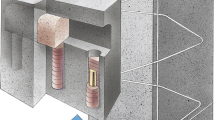Abstract
Hydrogeologic parameters evaluated for rocks investigated in deep well testing projects for nuclear waste repository feasibility are transmissivity, hydraulic conductivity and storativity. Such studies have been carried out in rock formations of different geologic types, origins and ages for nuclear waste management agencies in North America and Europe. From transient pressure testing, an assessment of static pressure in selected fracture zones was measured from which a profile with depth was developed using modelling techniques. As well, temperatures of formation fluids and hence thermal gradients have also been provided.
Hydrogeologic parameters are commonly used in risk analysis for repositories with respect to the possible escape of contaminants and worst case scenarios. The parameters are related to the rate of possible radionuclide migration into the biosphere. The techniques of the investigation and analysis methods of this work have been fully described in the literature. This paper is the first to date, however, to compare results from testing in differen geologic environments.
High transmissivity zones have been observed in the upper few hundred metres of granite formations. Below that depth, the rock is more competent and discrete zones of higher permeability occur less frequently. Our studies show, however, that in these rocks, zones of high hydraulic conductivity do not always correspond to zones of high fracture frequency.
Most formation pressure profiles have a vertical gradient of about 10 kPa/m. In discrete zones, deviations from this trend can occur due to vertical inhomogeneity in the rock. Thermal gradients vary considerably from one investigation site to another. For example, in the Canadian Shield, gradients are of the order of 1.0 degree C per 100 m, whereas in similar rock types in Europe, the gradient is up to 4.0 degrees C per 100 m.
Résumé
Les paramètres hydrogéologiques mesurés dans des roches étudiées dans des projets d'essai en puits profond pour étudier la possibilité de dépôts de déchets nucléaires sont la transmissivité, la conductivité hydraulique et la propriété d'emmagasinage. Ces études ont été conduites dans des formations rocheuses de types, d'origines et d'âges géologiques différents pour des agences nord-américaines et européennes de gestion des déchets nucléaires. À partir du contrôle du mouvement transitoire de pression, une évaluation de la pression statique dans des zones de fractures sélectionnées a été faite et il en a été déduit une coupe verticale, mettant en œuvre des techniques de modélisation. En outre, les températures des fluides de formation et, en conséquence, les gradients thermiques ont également été indiqués.
Les paramètres hydrogéologiques sont couramment utilisés dans l'analyse des risques des dépôts a l'égard du dégagement possible de contaminants et des études de cas les plus défavorables. Les paramètres sont rattachés au régime de migration possible des radionucléides dans la biosphère. Les techniques de recherche et les méthodes d'analyse de cet ouvrage ont été décrites en détail dans la documentation. Ce document est cependant le premier à ce jour qui compare les résultats des essais dans différents milieux géologiques.
Les zones de transmissivité ont été observées dans les quelques centaines de mètres supérieurs des formations granitiques. Au-dessous de cette profondeur, la roche est plus compétente et les zones discrètes de perméabilité plus élevée se présentent moins fréquemment. Nos études révèlent cependant que, dans ces roches, les zones de conductivité hydraulique élevée ne correspondent pas toujours aux zones à haute fréquence de fractures.
La plupart des profils de pression de formation ont un gradient vertical d'environ 10 kPa/m. Dans certaines zones des écarts par rapport à cette tendance peuvent se produire du fait du manque d'homogénéité verticale de la roche. Les gradients thermiques varient énormément d'un lieu de recherche à l'autre. Par exemple, dans le Bouclier canadien, les gradients sont de l'ordre de 1.o°C par 100 mètres, alors que dans des types rocheux similaires d'Europe, le gradient atteint 4°C par 100 mètres.
Similar content being viewed by others
References
BROWN P.A., KAMINENI C., STONE D., THIVIERGE R.H. (1980): General Geology of the Eye-Dashwa Lakes Pluton, Atikokan, Northwestern Ontario. Atomic Energy of Canada Limited Technical Record. TR-108, 14 p.
KENNEDY K.G., HOLLINGSHEAD S.C., LEECH R.E.J. (1985): Determining head and pressure distribution in low transmissivity formations and soils.Proc. Third National Symposium and Exposition on Ground Water Instrumentation. National Water Well Assoc., Worthington, Ohio.
KENNEDY K.G., McLAREN R.G. (1985): The application of wellbore simulators to transient pressure test design and analysis.Proc. 24th Annual Conference Ontario Petroleum Institute, Ontario Petroleum Institute, London, Canada.
KENNEDY K.G., MILLER W. (1980): Downhole double packer instrumentation.Proc. 3rd International Symposium on well testing, University of California Press, Berkeley.
LEE P.K., PEARSON R., LEECH R.E.J., DICKEN R. (1983): Hydraulic testing of deep fractures in the Canadian Shield.Bulletin of the International Association of Engineering Geology. No. 26-7, Paris.
LEECH R.E.J. (1981): Deep borehole testing techniques developed for Canada's nuclear fuel waste management program.Studies in Environmental Science, Volume 17, Elsevier Scientific Publishing Co., The Netherlands.
McEWEN T.J., McCANN D.M., SHERLOCK S. (1985): Fracture analysis from borehole geophysical techniques in crystalline rocks. Quarterly Journal of Engineering Geology, London, Vol. 18, No. 4, 413–436.
McLAREN R.G., SUDICKY E.A., KENNEDY K.G. (1985): Simulation of non-ideal pressure response tests in low hydraulic conductivity rock.Proc. Conference on practical applications of ground water models, National Water Well Assoc., Worthington, Ohio.
NAGRA (1985): Sondierbohrung Boettstein Untersuchungsbericht.Technischer Bericht 85-01, NAGRA, Baden, Schweiz.
STONE D. (1980): Distribution of near vertical surface fractures in the Dashwa Pluton, Atikokan, Ontario. Atomic Energy of Canada Limited Technical Record, TR-125.
UPDEGRAFF C.D., KENNEDY K.G., CULVER C.N. BAKR A.A., KAM J.T. (1980): Testing low to moderately transmissive zones in basalt rocks. Presented to the Third Invitational Well Testing Symposium in Low Permeability Rock, Berkeley CA. March 26–28, 1980.
Author information
Authors and Affiliations
Rights and permissions
About this article
Cite this article
Kennedy, K.G., Leech, R.E.J. Comparison of hydrogeologic parameters evaluated by deep well testing programs to assess nuclear waste repository feasibility. Bulletin of the International Association of Engineering Geology 34, 15–23 (1986). https://doi.org/10.1007/BF02590231
Issue Date:
DOI: https://doi.org/10.1007/BF02590231




